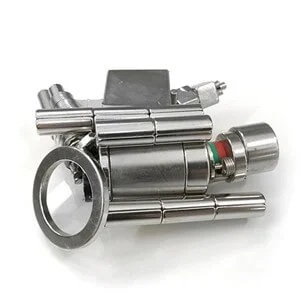Types and Grades of Magnets
May 18th 2023
Listen to this Article
Magnets of different shapes and types
- Permanent Magnets:
- Alnico Magnets: Alnico magnets are made from a combination of aluminum (Al), nickel (Ni), and cobalt (Co), along with small amounts of other elements such as copper and titanium. Alnico magnets are known for their high coercivity and temperature stability. Common grades include Alnico 2, Alnico 5, and Alnico 8, each with different magnetic properties.
- Ceramic Magnets: Ceramic magnets, also known as ferrite magnets, are composed of iron oxide (Fe203) and ceramic materials. They are affordable, have good resistance to demagnetization, and can operate in high-temperature environments. Ceramic magnets are typically available in grades such as C1, C5, and C8, with C11 being the strongest.
- Rare Earth Magnets:
- Neodymium Iron Boron (NdFeB) Magnets: NdFeB magnets are the strongest commercially available magnets. They are made of neodymium (Nd), iron (Fe), and boron (B), and sometimes contain other elements. NdFeB magnets have high magnetic energy and excellent strength. They are available in various grades such as N35, N42, N52, etc., indicating their maximum energy product (measured in Mega-Gauss Oersteds, MGOe).
- Samarium Cobalt (SmCo) Magnets: SmCo magnets are composed of samarium (Sm), cobalt (Co), and sometimes other rare earth metals. They have high magnetic strength, excellent temperature stability, and resistance to corrosion. SmCo magnets are available in grades such as SmCo5 and Sm2Co17, indicating their respective compositions.
- Flexible Magnets:
- Flexible Magnetic Sheets: Flexible magnets are typically made by mixing ferrite powders with a flexible polymer binder, such as rubber or vinyl. They are often used in applications like refrigerator magnets and signage. Flexible magnets generally do not have specific grades, but their strength can vary based on the thickness and composition of the material.
- Electromagnets:
- Electromagnets are temporary magnets created by passing an electric current through a coil. The strength of an electromagnet depends on factors such as the number of turns in the coil, the amount of current flowing through it, and the core material used (e.g., iron or steel). Electromagnets are widely used in applications such as magnetic resonance imaging (MRI), industrial lifting systems, and speakers.
It's important to note that magnets can have specific properties and grades beyond the ones mentioned here, depending on the manufacturer, application, and specialized requirements. Therefore, it's always advisable to consult specific manufacturers or references for detailed information on magnet types and grades.
May 18th 2023

